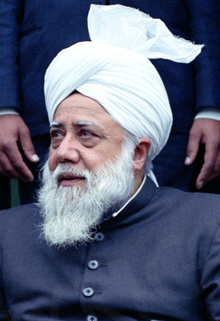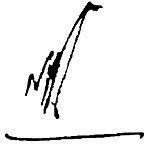
Back مرزا ناصر أحمد Arabic Mirza Nasir Ahmad German میرزا ناصر احمد Persian Mirza Nasir Ahmad French Mirza Nasir Ahmad ID Мырза Насир Ахмад Kirghiz Mirza Nasir Ahmad Dutch Mirza Nasir Ahmad NB Мирза Насир Ахмад Russian Mirza Nasir Ahmed Albanian
Mirza Nasir Ahmad | |
|---|---|
مرزا ناصر احمد | |
 Mirza Nasir Ahmad in 1967 | |
| Personal life | |
| Born | 16 November 1909 |
| Died | 9 June 1982 (aged 72) |
| Resting place | Bahishti Maqbara, Rabwah, Pakistan |
| Spouse |
|
| Parents |
|
| Signature |  |
| Religious life | |
| Religion | Islam |
| Denomination | Ahmadiyya |
| Consecration | 8 November 1965[2] |
| Muslim leader | |
| Post | Caliph |
| Predecessor | Mirza Basheer-ud-Din Mahmood Ahmad |
| Successor | Mirza Tahir Ahmad |
| Part of a series on
Ahmadiyya |
|---|
 |
Mirza Nasir Ahmad (مرزا ناصر احمد; 16 November 1909 – 9 June 1982) was the third Caliph (Arabic: خليفة المسيح الثالث, romanized: khalīfatul masīh al-Thālith) of the Ahmadiyya Muslim Community from Pakistan. He was elected as the third successor of Mirza Ghulam Ahmad on 8 November 1965, the day after the death of his predecessor and father, Mirza Basheer-ud-Din Mahmood Ahmad.
Under his leadership, there was further expansion of missionary work started by his predecessor the second caliph, particularly in Africa and Europe. In 1974, he represented the Ahmadiyya Community in the National Assembly of Pakistan in an eleven-day inquisition. Despite his efforts, the National Assembly declared Ahmadis to be non-Muslims and he led the Community through this period of increased hostility and government repression.[3] The 'Nusrat Jehan Scheme', a scheme dedicated to serving parts of Africa by running numerous medical clinics and schools was one of the many outcomes of his 1970 tour of West Africa, the first visit to the continent made by an Ahmadi caliph. In 1980, Nasir Ahmad traveled to Spain, where he laid the foundation stone of the Basharat Mosque in Pedro Abad and announced "Love for All, Hatred for None" as the community's motto.[4][5] The mosque was inaugurated posthumously in 1982 and was the first purpose-built mosque in Spain since the Reconquista and the Fall of Granada in 1492.[6][7][8]
Nasir Ahmad also orchestrated the compilation and arrangement of Ghulam Ahmad's literary output. The writings of Ghulam Ahmad, which had hitherto been published as individual books, pamphlets or articles were compiled in the twenty-three volume corpus known as Rūhānī Khazā᾽in (Spiritual Treasures). His sayings and discourses were collected in the ten volume Malfūzāt (spoken words) and his announcements and advertisements were published in three volumes under the title of Majmu'a Ishtihārāt (Collection of Flyers or Posters).[9][10]
- ^ The Life of Hadhrat Khalifatul Masih III (rh). Archived from the original on 13 December 2021.
- ^ Hadhrat Khalifatul Masih III(ru) – Election as Khalifa, Review of Religions, March, 2008
- ^ 2nd Amendment of Pakistan Constitution, Gazette of Pakistan, Extraordinary, Part I, 21 September 1974
- ^ ""Love for All, Hatred for None" - Historical Trip to Spain". The Review of Religions. 1 March 2008. Retrieved 28 March 2023.
- ^ M.A.Saqi: Laying the foundation of the Pedrobad Mosque. The Muslim Herald, 1982.
- ^ Roose, Eric (2009). The Architectural Representation of Islam: Muslim-commissioned Mosque Design in the Netherlands. Amsterdam University Press. p. 47. ISBN 9789089641335.
- ^ Yvonne Y. Haddad, Jane I. Smith: Mission to America. Five Islamic sectarian communities in North America. University Press of Florida, Gainesville 1993, p. 49
- ^ "Who are Ahmadi?". BBC News. 28 May 2010. Retrieved 9 January 2011.
- ^ "Hazrat Hafiz Mirza Nasir Ahmad". Retrieved 25 August 2014.
- ^ "An Introduction to the Hidden Treasures of Islam" (PDF). Retrieved 1 November 2019.